Home > Directory Home > Drawing Lessons > How to Draw Caricatures & Cartoon Faces >Apply Your Knowledge of Artists Techniques to Drawing Caricatures
How to draw caricatures and comics with applied knowledge of artists techniques
|
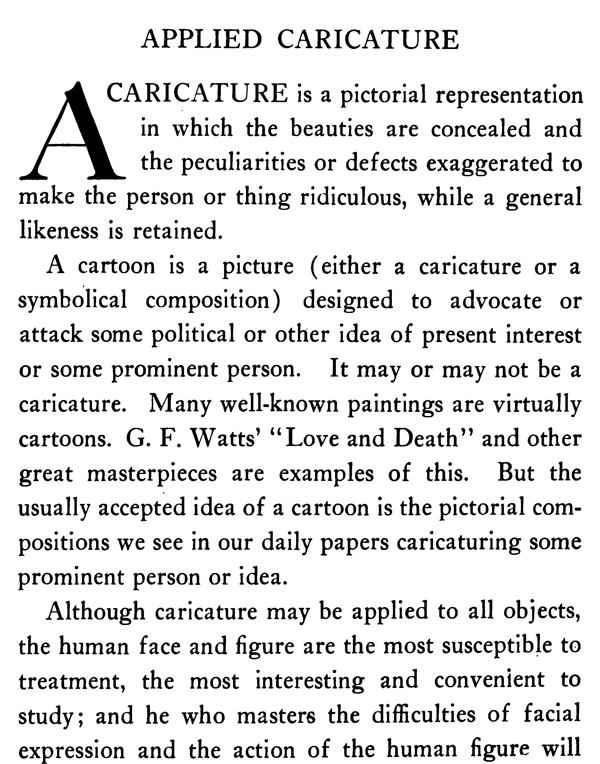
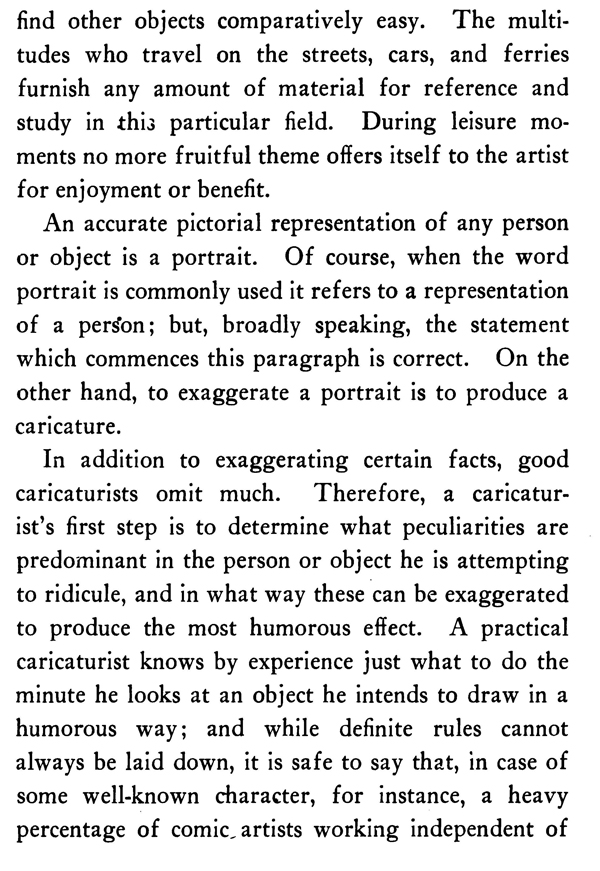
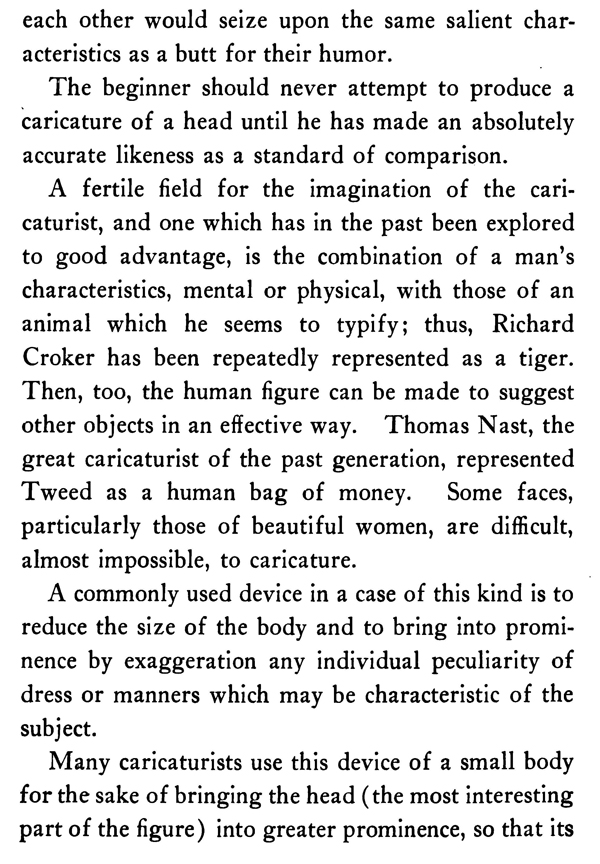
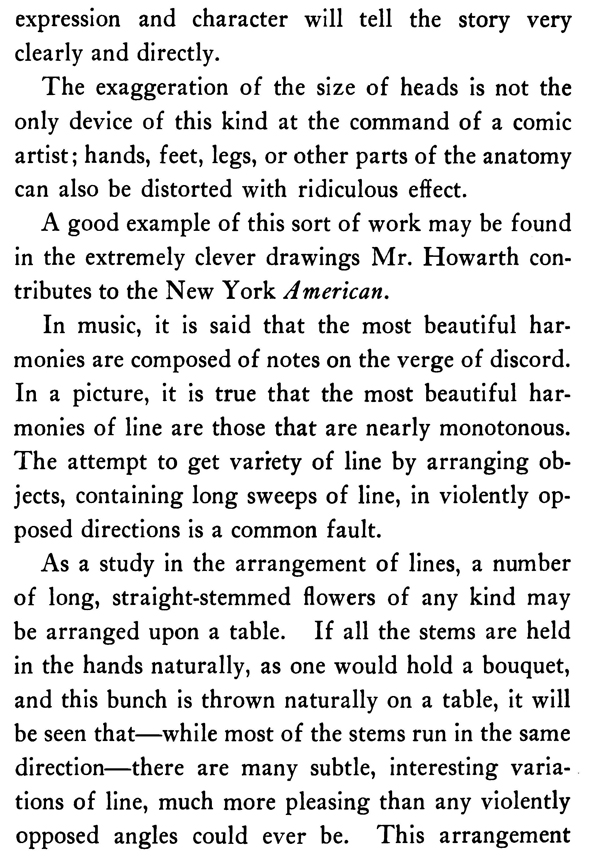

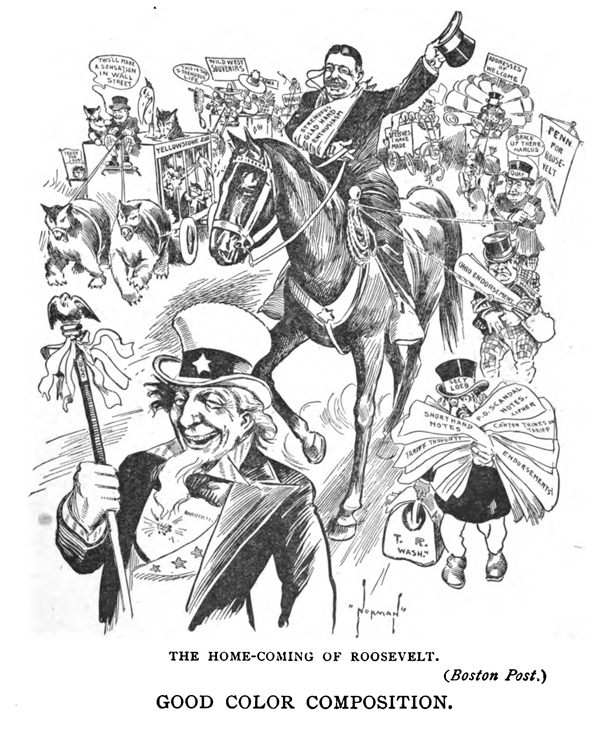
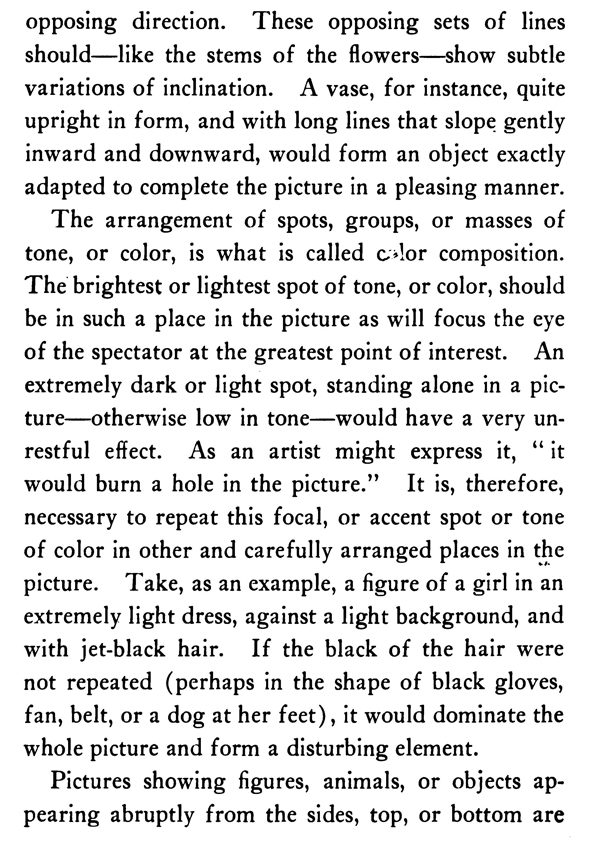
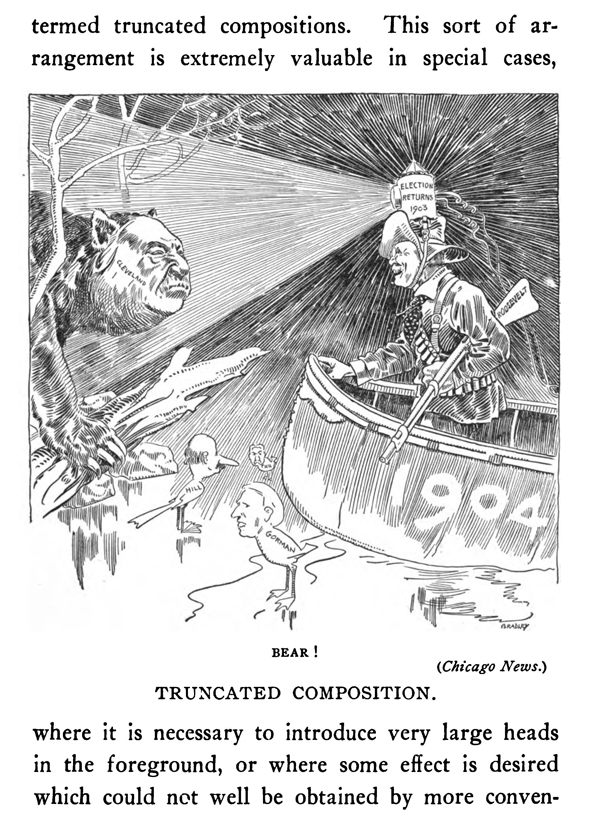
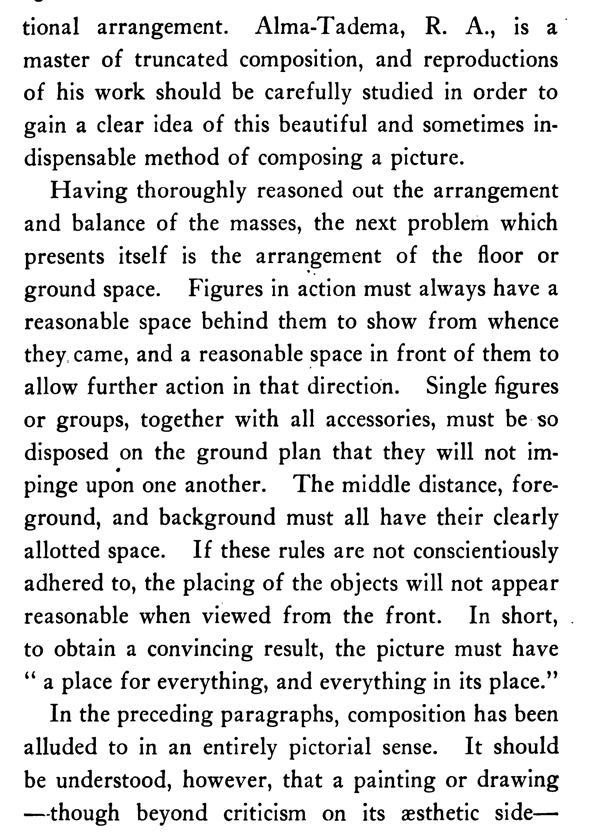
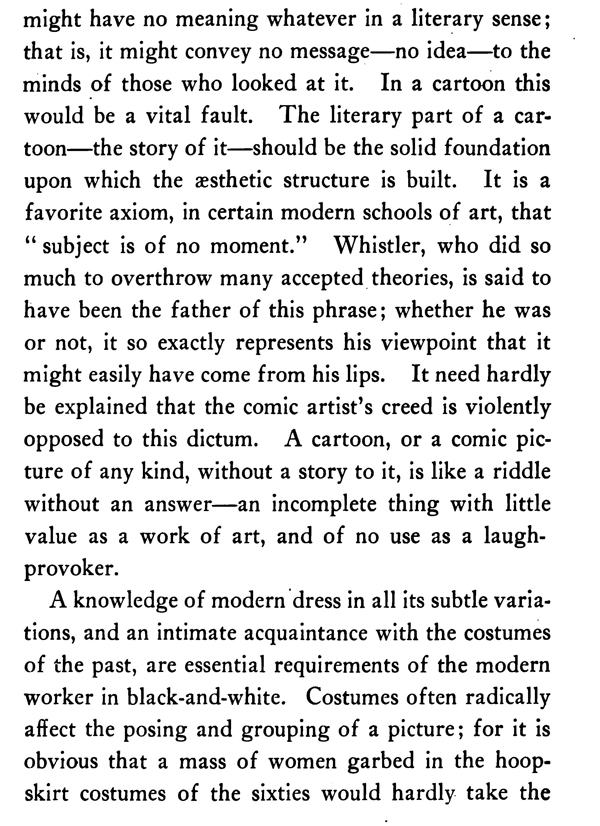
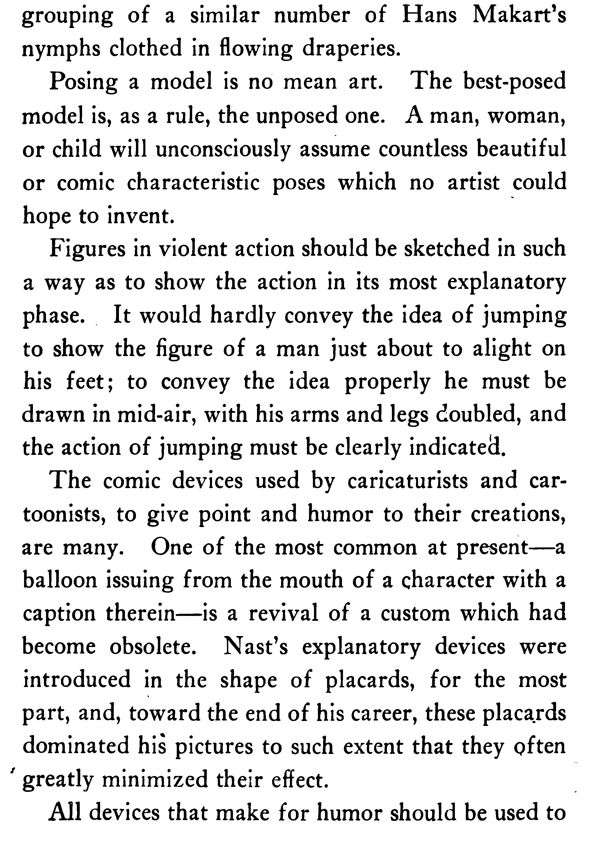

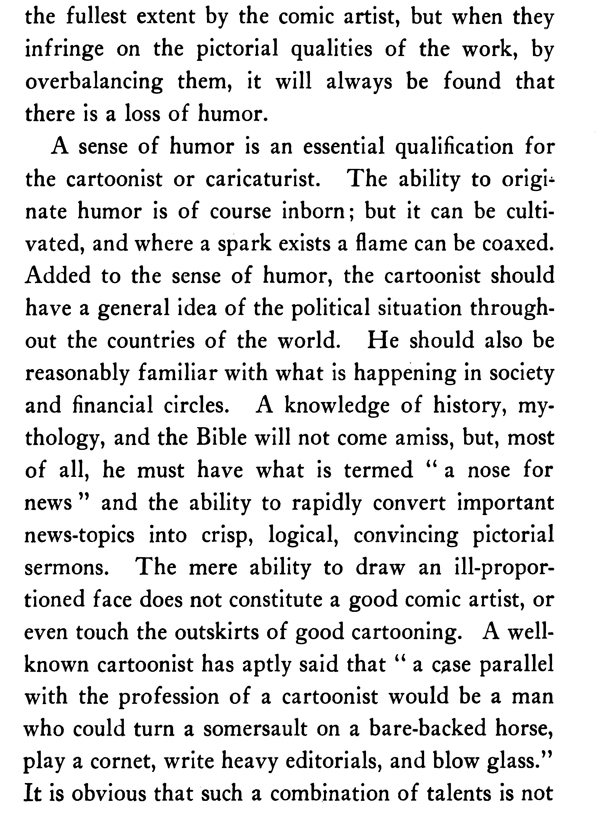
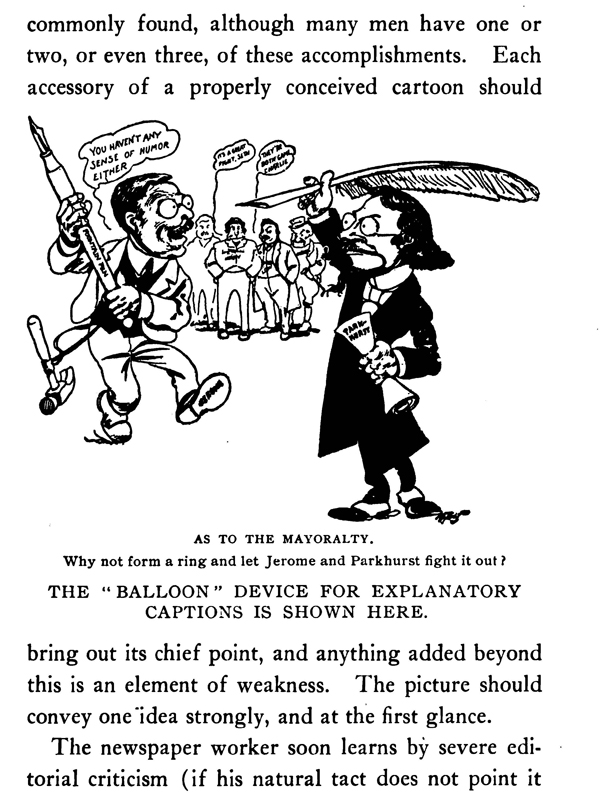
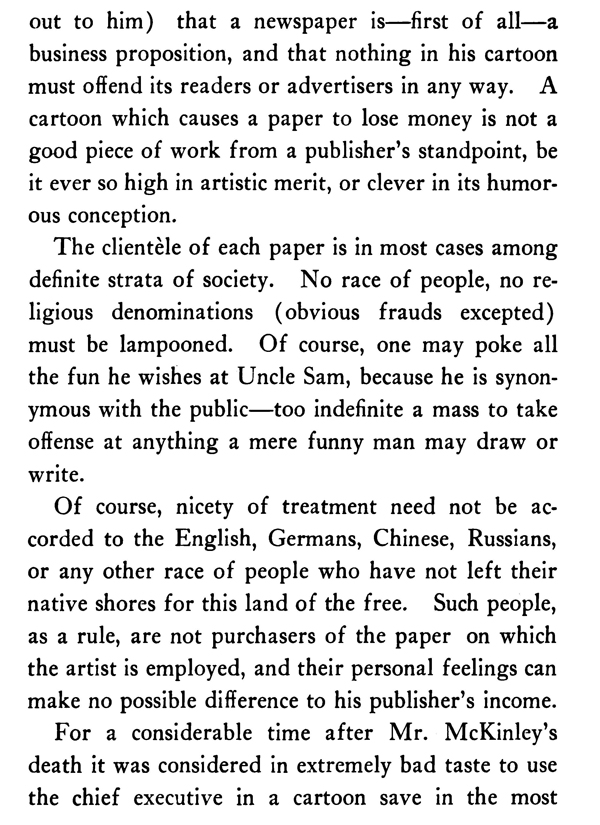
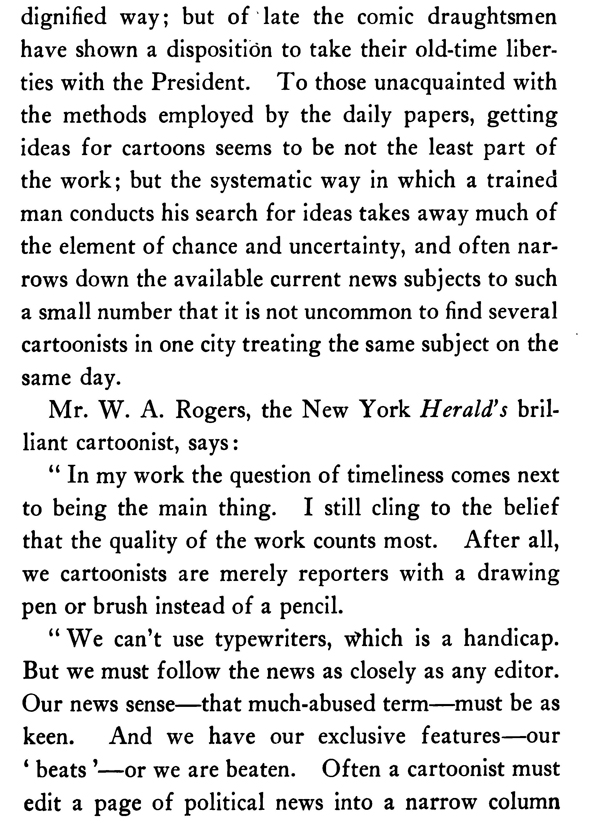
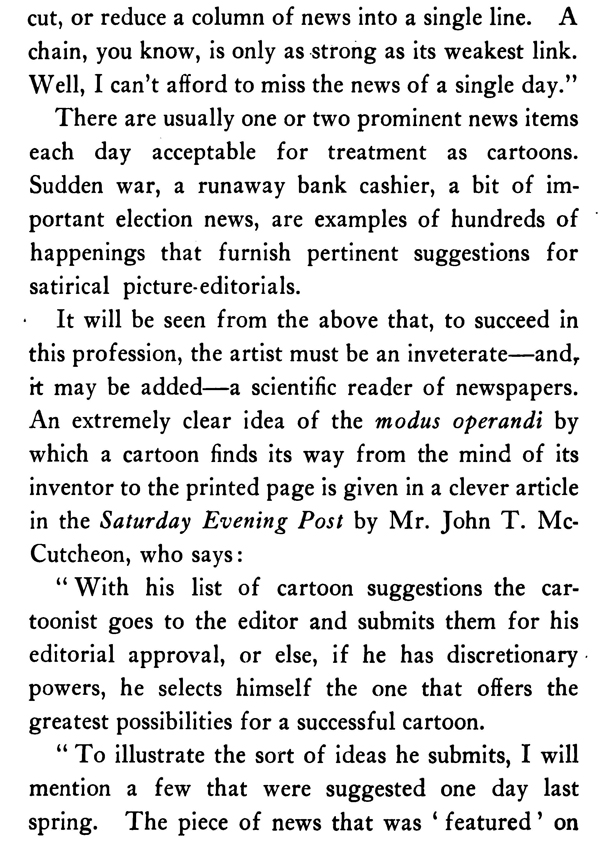
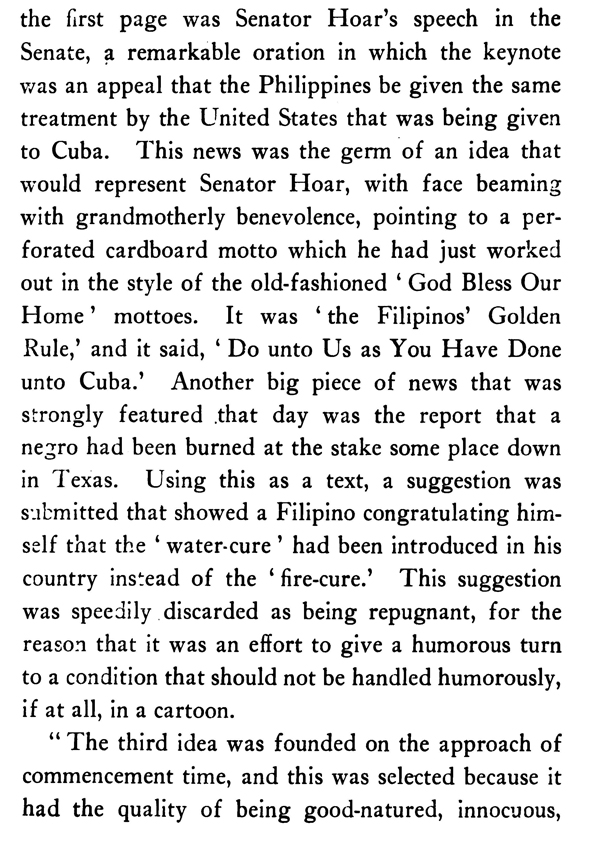
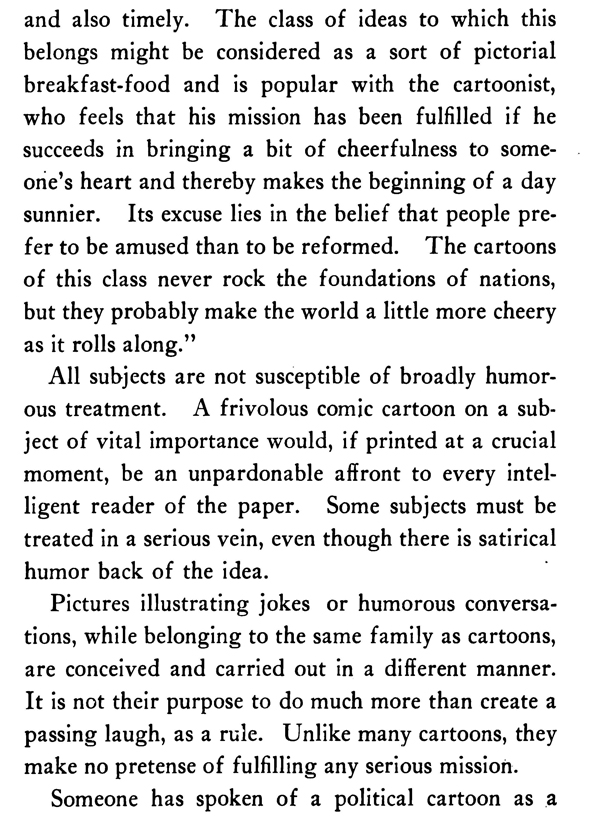
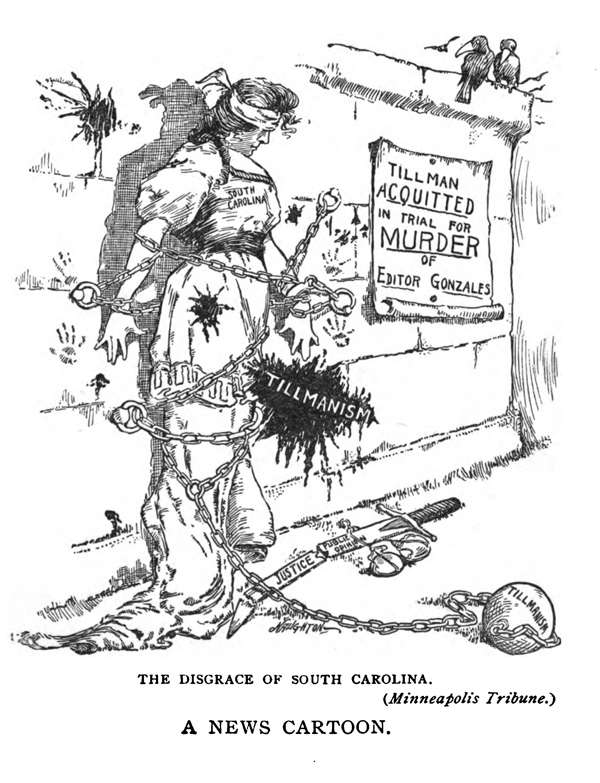
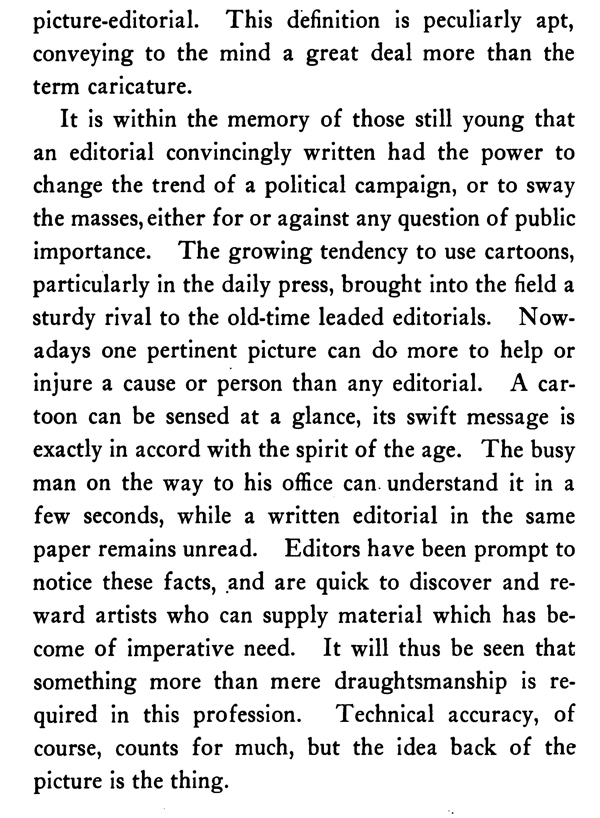
GO BACK TO THE HOME PAGE FOR CARICATURE DRAWING TUTORIALS
[The above words are pictures of text, below is the actual text if you need to copy a paragraph or two]
APPLIED CARICATURE
CARICATURE is a pictorial representation in which the beauties are concealed and the peculiarities or defects exaggerated to make the person or thing ridiculous, while a general likeness is retained.
A cartoon is a picture (either a caricature or a symbolical composition) designed to advocate or attack some political or other idea of present interest or some prominent person. It may or may not be a caricature. Many well-known paintings are virtually cartoons. G. F. Watts' "Love and Death" and other great masterpieces are examples of this. But the usually accepted idea of a cartoon is the pictorial compositions we see in our daily papers caricaturing some prominent person or idea.
Although caricature may be applied to all objects, the human face and figure are the most susceptible to treatment, the most interesting and convenient to study; and he who masters the difficulties of facial expression and the action of the human figure will find other objects comparatively easy. The multitudes who travel on the streets, cars, and ferries furnish any amount of material for reference and study in this particular field. During leisure moments no more fruitful theme offers itself to the artist for enjoyment or benefit.
An accurate pictorial representation of any person or object is a portrait. Of course, when the word portrait is commonly used it refers to a representation of a per§on; but, broadly speaking, the statement which commences this paragraph is correct. On the other hand, to exaggerate a portrait is to produce a caricature.
In addition to exaggerating certain facts, good caricaturists omit much. Therefore, a caricaturist's first step is to determine what peculiarities are predominant in the person or object he is attempting to ridicule, and in what way these can be exaggerated to produce the most humorous effect. A practical caricaturist knows by experience just what to do the minute he looks at an object he intends to draw in a humorous way; and while definite rules cannot always be laid down, it is safe to say that, in case of some well-known character, for instance, a heavy percentage of comic...artists working independent of each other would seize upon the same salient characteristics as a butt for their humor.
The beginner should never attempt to produce a caricature of a head until he has made an absolutely accurate likeness as a standard of comparison.
A fertile field for the imagination of the caricaturist, and one which has in the past been explored to good advantage, is the combination of a man's characteristics, mental or physical, with those of an animal which he seems to typify; thus, Richard Croker has been repeatedly represented as a tiger. Then, too, the human figure can be made to suggest other objects in an effective way. Thomas Nast, the great caricaturist of the past generation, represented Tweed as a human bag of money. Some faces, particularly those of beautiful women, are difficult, almost impossible, to caricature.
A commonly used device in a case of this kind is to reduce the size of the body and to bring into prominence by exaggeration any individual peculiarity of dress or manners which may be characteristic of the subject.
Many caricaturists use this device of a small body for the sake of bringing the head (the most interesting part of the figure) into greater prominence, so that its expression and character will tell the story very clearly and directly. The exaggeration of the size of heads is not the only device of this kind at the command of a comic artist; hands, feet, legs, or other parts of the anatomy can also be distorted with ridiculous effect.
A good example of this sort of work may be found in the extremely clever drawings Mr. Howarth contributes to the New York American.
In music, it is said that the most beautiful harmonies are composed of notes on the verge of discord. In a picture, it is true that the most beautiful harmonies of line are those that are nearly monotonous. The attempt to get variety of line by arranging objects, containing long sweeps of line, in violently opposed directions is a common fault.
AN ARRANGEMENT IN OPPOSING MASSES OF LINES
As a study in the arrangement of lines, a number of long, straight-stemmed flowers of any kind may be arranged upon a table. If all the stems are held in the hands naturally, as one would hold a bouquet, and this bunch is thrown naturally on a table, it will be seen that—while most of the stems run in the same direction—there are many subtle, interesting variations of line, much more pleasing than any violently opposed angles could ever be. This arrangement however, will be found lacking, because all of the lines in it tend in the s-trr e direction. This set of lines must, in order to form a good composition, be broken with one or more sets of lines running in an opposing direction. These opposing sets of lines should—like the stems of the flowers—show subtle variations of inclination. A vase, for instance, quite upright in form, and with long lines that slope gently inward and downward, would form an object exactly adapted to complete the picture in a pleasing manner.
GOOD COLOR COMPOSITION.
The arrangement of spots, groups, or masses of tone, or color, is what is called valor composition. The brightest or lightest spot of tone, or color, should be in such a place in the picture as will focus the eye of the spectator at the greatest point of interest. An extremely dark or light spot, standing alone in a picture—otherwise low in tone—would have a very unrestful effect. As an artist might express it, " it would burn a hole in the picture." It is, therefore, necessary to repeat this focal, or accent spot or tone of color in other and carefully arranged places in the picture. Take, as an example, a figure of a girl in an extremely light dress, against a light background, and with jet-black hair. If the black of the hair were not repeated (perhaps in the shape of black gloves, fan, belt, or a dog at her feet), it would dominate the whole picture and form a disturbing element.
Pictures showing figures, animals, or objects appearing abruptly from the sides, top, or bottom are termed truncated compositions. This sort of arrangement is extremely valuable in special cases,
TRUNCATED COMPOSITION.
where it is necessary to introduce very large heads in the foreground, or where some effect is desired which could not well be obtained by more conventional arrangement. Alma-Tadema, R. A., is a master of truncated composition, and reproductions of his work should be carefully studied in order to gain a clear idea of this beautiful and sometimes indispensable method of composing a picture.
Having thoroughly reasoned out the arrangement and balance of the masses, the next problem which presents itself is the arrangement of the floor or ground space. Figures in action must always have a reasonable space behind them to show from whence they came, and a reasonable space in front of them to allow further action in that direction. Single figures or groups, together with all accessories, must be so disposed on the ground plan that they will not impinge upon one another. The middle distance, foreground, and background must all have their clearly allotted space. If these rules are not conscientiously adhered to, the placing of the objects will not appear reasonable when viewed from the front. In short, to obtain a convincing result, the picture must have " a place for everything, and everything in its place."
In the preceding paragraphs, composition has been alluded to in an entirely pictorial sense. It should be understood, however, that a painting or drawing --though beyond criticism on its aesthetic side might have no meaning whatever in a literary sense; that is, it might convey no message—no idea—to the minds of those who looked at it. In a cartoon this would be a vital fault. The literary part of a cartoon—the story of it—should be the solid foundation upon which the esthetic structure is built. It is a favorite axiom, in certain modern schools of art, that " subject is of no moment." Whistler, who did so much to overthrow many accepted theories, is said to have been the father of this phrase; whether he was or not, it so exactly represents his viewpoint that it might easily have come from his lips. It need hardly be explained that the comic artist's creed is violently opposed to this dictum. A cartoon, or a comic picture of any kind, without a story to it, is like a riddle without an answer—an incomplete thing with little value as a work of art, and of no use as a laugh-provoker.
A knowledge of modern 'dress in all its subtle variations, and an intimate acquaintance with the costumes of the past, are essential requirements of the modern worker in black-and-white. Costumes often radically affect the posing and grouping of a picture; for it is obvious that a mass of women garbed in the hoop-skirt costumes of the sixties would hardly take the grouping of a similar number of Hans Makart's nymphs clothed in flowing draperies.
Posing a model is no mean art. The best-posed model is, as a rule, the unposed one. A man, woman, or child will unconsciously assume countless beautiful or comic characteristic poses which no artist could hope to invent.
Figures in violent action should be sketched in such a way as to show the action in its most explanatory phase. It would hardly convey the idea of jumping to show the figure of a man just about to alight on his feet; to convey the idea properly he must be drawn in mid-air, with his arms and legs doubled, and the action of jumping must be clearly indicated.
The comic devices used by caricaturists and cartoonists, to give point and humor to their creations, are many. One of the most common at present—a balloon issuing from the mouth of a character with a caption therein—is a revival of a custom which had become obsolete. Nast's explanatory devices were introduced in the shape of placards, for the most part, and, toward the end of his career, these placards dominated hii pictures to such extent that they often greatly minimized their effect.
FIGURES SHOWING ACTION IN ITS MOST EXPLANATORY PHASES.
the fullest extent by the comic artist, but when they infringe on the pictorial qualities of the work, by overbalancing them, it will always be found that there is a loss of humor.
A sense of humor is an essential qualification for the cartoonist or caricaturist. The ability to originate humor is of course inborn ; but it can be cultivated, and where a spark exists a flame can be coaxed. Added to the sense of humor, the cartoonist should have a general idea of the political situation throughout the countries of the world. He should also be reasonably familiar with what is happening in society and financial circles. A knowledge of history, mythology, and the Bible will not come amiss, but, most of all, he must have what is termed " a nose for news " and the ability to rapidly convert important news-topics into crisp, logical, convincing pictorial sermons. The mere ability to draw an ill-proportioned face does not constitute a good comic artist, or even touch the outskirts of good cartooning. A well-known cartoonist has aptly said that " a case parallel with the profession of a cartoonist would be a man who could turn a somersault on a bare-backed horse, play a cornet, write heavy editorials, and blow glass." It is obvious that such a combination of talents is not commonly found, although many men have one or two, or even three, of these accomplishments. Each accessory of a properly conceived cartoon should bring out its chief point, and anything added beyond this is an element of weakness. The picture should convey one 'idea strongly, and at the first glance. The newspaper worker soon learns by severe editorial criticism (if his natural tact does not point it out to him) that a newspaper is—first of all—a business proposition, and that nothing in his cartoon must offend its readers or advertisers in any way. A cartoon which causes a paper to lose money is not a good piece of work from a publisher's standpoint, be it ever so high in artistic merit, or clever in its humorous conception.
The clientele of each paper is in most cases among definite strata of society. No race of people, no religious denominations (obvious frauds excepted) must be lampooned. Of course, one may poke all the fun he wishes at Uncle Sam, because he is synonymous with the public—too indefinite a mass to take offense at anything a mere funny man may draw or write.
Of course, nicety of treatment need not be accorded to the English, Germans, Chinese, Russians, or any other race of people who have not left their native shores for this land of the free. Such people, as a rule, are not purchasers of the paper on which the artist is employed, and their personal feelings can make no possible difference to his publisher's income.
For a considerable time after Mr. McKinley's death it was considered in extremely bad taste to use the chief executive in a cartoon save in the most dignified way; but of late the comic draughtsmen have shown a disposition to take their old-time liberties with the President. To those unacquainted with the methods employed by the daily papers, getting ideas for cartoons seems to be not the least part of the work; but the systematic way in which a trained man conducts his search for ideas takes away much of the element of chance and uncertainty, and often narrows down the available current news subjects to such a small number that it is not uncommon to find several cartoonists in one city treating the same subject on the same day.
Mr. W. A. Rogers, the New York Herald's brilliant cartoonist, says :
"In my work the question of timeliness comes next to being the main thing. I still cling to the belief that the quality of the work counts most. After all, we cartoonists are merely reporters with a drawing pen or brush instead of a pencil.We can't use typewriters, which is a handicap. But we must follow the news as closely as any editor. Our news sense—that much-abused term—must be as keen. And we have our exclusive features—our ' beats '—or we are beaten. Often a cartoonist must edit a page of political news into a narrow column cut, or reduce a column of news into a single line. A chain, you know, is only as strong as its weakest link. Well, I can't afford to miss the news of a single day."
There are usually one or two prominent news items each day acceptable for treatment as cartoons. Sudden war, a runaway bank cashier, a bit of important election news, are examples of hundreds of happenings that furnish pertinent suggestions for satirical picture-editorials.
It will be seen from the above that, to succeed in this profession, the artist must be an inveterate—and, it may be added—a scientific reader of newspapers. An extremely clear idea of the modus operandi by which a cartoon finds its way from the mind of its inventor to the printed page is given in a clever article in the Saturday Evening Post by Mr. John T. McCutcheon, who says : " With his list of cartoon suggestions the cartoonist goes to the editor and submits them for his editorial approval, or else, if he has discretionary powers, he selects himself the one that offers the greatest possibilities for a successful cartoon.
"To illustrate the sort of ideas he submits, I will mention a few that were suggested one day last spring. The piece of news that was ' featured' on the first page was Senator Hoar's speech in the Senate, a remarkable oration in which the keynote was an appeal that the Philippines be given the same treatment by the United States that was being given to Cuba. This news was the germ of an idea that would represent Senator Hoar, with face beaming with grandmotherly benevolence, pointing to a perforated cardboard motto which he had just worked out in the style of the old-fashioned God Bless Our Home' mottoes. It was the Filipinos' Golden Rule,' and it said, Do unto Us as You Have Done unto Cuba.' Another big piece of news that was strongly featured that day was the report that a negro had been burned at the stake some place down in Texas. Using this as a text, a suggestion was snbmitted that showed a Filipino congratulating himself that the `water-cure' had been introduced in his country instead of the fire-cure.' This suggestion was speedily discarded as being repugnant, for the reason that it was an effort to give a humorous turn to a condition that should not be handled humorously, if at all, in a cartoon."
The third idea was founded on the approach of commencement time, and this was selected because it had the quality of being good-natured, innocuous, and also timely. The class of ideas to which this belongs might be considered as a sort of pictorial breakfast-food and is popular with the cartoonist, who feels that his mission has been fulfilled if he succeeds in bringing a bit of cheerfulness to someone's heart and thereby makes the beginning of a day sunnier. Its excuse lies in the belief that people prefer to be amused than to be reformed. The cartoons of this class never rock the foundations of nations, but they probably make the world a little more cheery as it rolls along."
All subjects are not susceptible of broadly humorous treatment. A frivolous comic cartoon on a subject of vital importance would, if printed at a crucial moment, be an unpardonable affront to every intelligent reader of the paper. Some subjects must be treated in a serious vein, even though there is satirical humor back of the idea.
Pictures illustrating jokes or humorous conversations, while belonging to the same family as cartoons, are conceived and carried out in a different manner. It is not their purpose to do much more than create a passing laugh, as a rule. Unlike many cartoons, they make no pretense of fulfilling any serious mission.Someone has spoken of a political cartoon as a picture-editorial. This definition is peculiarly apt, conveying to the mind a great deal more than the term caricature. It is within the memory of those still young that an editorial convincingly written had the power to change the trend of a political campaign, or to sway the masses, either for or against any question of public importance. The growing tendency to use cartoons, particularly in the daily press, brought into the field a sturdy rival to the old-time leaded editorials. Nowadays one pertinent picture can do more to help or injure a cause or person than any editorial. A cartoon can be sensed at a glance, its swift message is exactly in accord with the spirit of the age. The busy man on the way to his office can understand it in a few seconds, while a written editorial in the same paper remains unread. Editors have been prompt to notice these facts, and are quick to discover and reward artists who can supply material which has become of imperative need. It will thus be seen that something more than mere draughtsmanship is required in this profession. Technical accuracy, of course, counts for much, but the idea back of the picture is the thing.
Privacy Policy .... Contact Us




